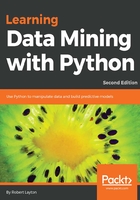
Getting Started with Data Mining
We are collecting information about our world on a scale that has never been seen before in the history of humanity. Along with this trend, we are now placing more day-to-day importance on the use of this information in everyday life. We now expect our computers to translate web pages into other languages, predict the weather with high accuracy, suggest books we would like, and to diagnose our health issues. These expectations will grow into the future, both in application breadth and efficacy. Data Mining is a methodology that we can employ to train computers to make decisions with data and forms the backbone of many high-tech systems of today.
The Python programming language is fast growing in popularity, for a good reason. It gives the programmer flexibility, it has many modules to perform different tasks, and Python code is usually more readable and concise than in any other languages. There is a large and an active community of researchers, practitioners, and beginners using Python for data mining.
In this chapter, we will introduce data mining with Python. We will cover the following topics
- What is data mining and where can we use it?
- Setting up a Python-based environment to perform data mining
- An example of affinity analysis, recommending products based on purchasing habits
- An example of (a classic) classification problem, predicting the plant species based on its measurement